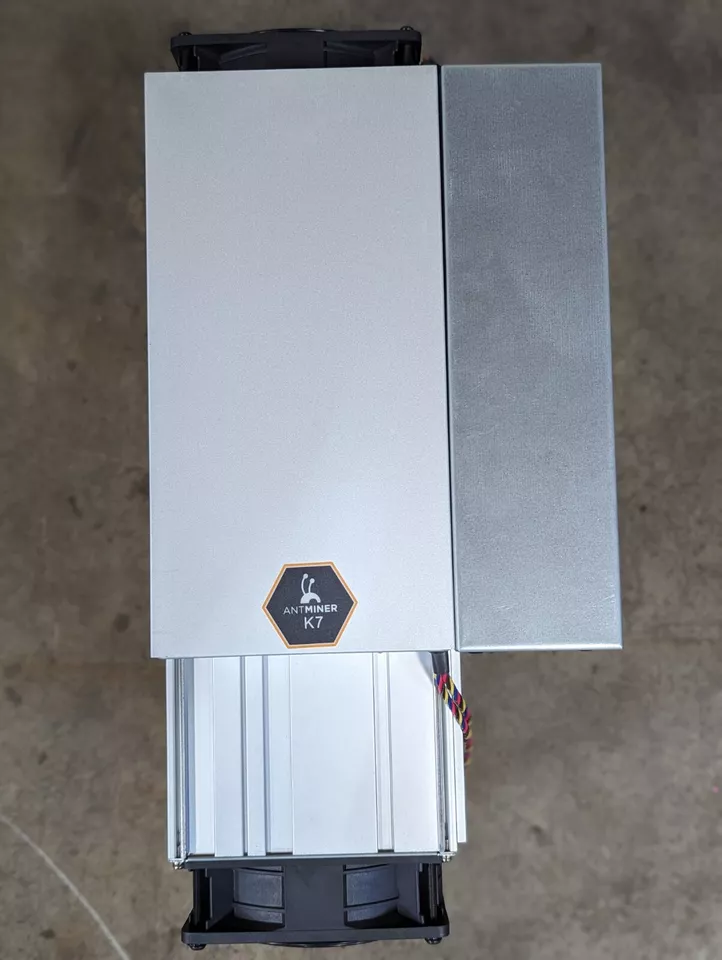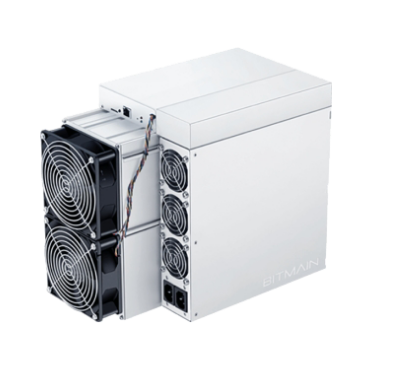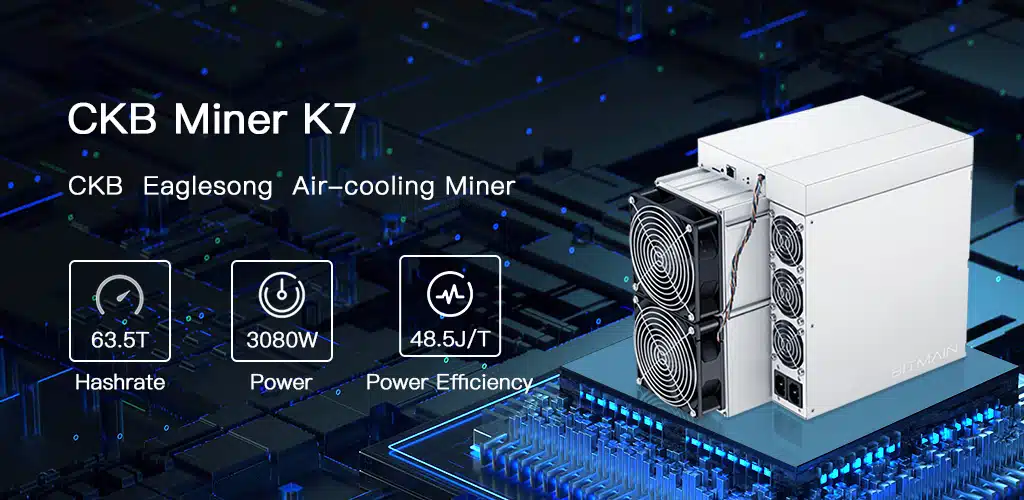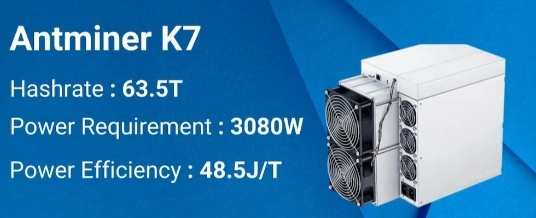CKB Miner K7 Overclocking Settings Guide
The CKB Miner K7 is a game-changer in the world of cryptocurrency mining, specifically designed for the Eaglesong algorithm that powers CKB (Nervos Network). As one of the most efficient and powerful miners on the market, the K7 offers unparalleled performance and reliability. However, to truly maximize its potential, understanding and implementing optimal overclocking settings is essential. This guide will walk you through the process of overclocking the CKB Miner K7, ensuring you get the most out of your mining operation.
Introduction to the CKB Miner K7
Before diving into overclocking, let’s take a closer look at what makes the CKB Miner K7 such a standout product. Developed by Bitmain, a leader in cryptocurrency mining hardware, the K7 is engineered for the Eaglesong algorithm, which is the backbone of the CKB blockchain.

The K7 boasts a hashrate of 63.5 TH/s (±3%), making it one of the most powerful miners for CKB. Its energy efficiency is equally impressive, with a power consumption of 3080W (±5%) and a power efficiency of 48.5 J/TH. These metrics ensure that the K7 not only delivers high performance but also keeps operational costs in check.
The miner’s dual AC input design (200-240V, 50-60Hz) and Ethernet connectivity (10/100M) make it versatile and easy to integrate into existing setups. Additionally, its compact form factor (430 x 195.5 x 290mm) allows for efficient deployment in various mining environments, from small-scale operations to large-scale farms.
Why Overclock the CKB Miner K7?
Overclocking is the process of pushing your mining hardware beyond its factory settings to achieve higher performance. For the CKB Miner K7, this means increasing the hashrate to mine more CKB in less time. However, overclocking also comes with trade-offs, such as increased power consumption and heat generation. When done correctly, overclocking can significantly boost your mining profitability, but it requires careful calibration to avoid damaging the hardware.

Key Considerations Before Overclocking
Before you start overclocking, keep the following factors in mind:
- Cooling Solutions: Overclocking generates additional heat, so ensure your mining environment has adequate cooling. Consider upgrading to industrial-grade fans or liquid cooling systems if necessary.
- Power Supply: Higher performance means higher power consumption. Verify that your power supply can handle the increased load without tripping or causing instability.
- Hardware Longevity: Pushing your miner too hard can shorten its lifespan. Balance performance gains with the need for sustainable, long-term operation.
- Warranty Implications: Overclocking may void your warranty. Check Bitmain’s warranty terms before proceeding.
Step-by-Step Overclocking Guide for the CKB Miner K7
Step 1: Access the Miner’s Interface
- Connect your CKB Miner K7 to your network via Ethernet.
- Open a web browser and enter the miner’s IP address to access its control interface.
- Log in using the default credentials (usually root/root).
Step 2: Monitor Baseline Performance
Before making any changes, record the miner’s baseline metrics:

- Hashrate: Typically 63.5 TH/s.
- Power Consumption: Around 3080W.
- Temperature: Should be within the operating range of 0-40°C.
Step 3: Adjust Frequency Settings
- Navigate to the Advanced Settings or Overclocking tab in the control interface.
- Locate the Frequency Control option. The default frequency is optimized for stability, but you can increase it incrementally to boost performance.
- Start with a 5-10% increase in frequency and monitor the results. For example, if the default frequency is 500 MHz, try increasing it to 525-550 MHz.
Step 4: Fine-Tune Voltage
- Increasing frequency often requires a corresponding increase in voltage to maintain stability.
- In the same settings menu, adjust the Voltage Control option. Start with a small increase (e.g., +0.05V) and test the miner’s stability.
- Be cautious—excessive voltage can lead to overheating and hardware damage.
Step 5: Test Stability
After making adjustments, let the miner run for 15-30 minutes and monitor the following:
- Hashrate: Has it increased significantly?
- Temperature: Is it within safe limits?
- Power Consumption: Is it still manageable?
If the miner remains stable, you can continue increasing frequency and voltage in small increments.
Step 6: Optimize Cooling
As you push the miner harder, ensure your cooling system can handle the additional heat. Consider:
- Adding additional fans to improve airflow.
- Using thermal paste to enhance heat dissipation.
- Relocating the miner to a cooler environment if necessary.
Recommended Overclocking Settings for the CKB Miner K7
While every setup is different, here are some general guidelines for overclocking the K7:

- Frequency: Increase to 550-600 MHz for a 10-20% boost in hashrate.
- Voltage: Adjust to +0.05V to +0.1V above default settings.
- Fan Speed: Set to 80-100% to maintain optimal temperatures.
These settings should help you achieve a hashrate of 70-75 TH/s, depending on your cooling and power setup.
Real-World Benefits of Overclocking the CKB Miner K7
- Increased Profitability: A higher hashrate means more CKB mined per day, directly boosting your earnings.
- Better ROI: By maximizing your miner’s performance, you can achieve a faster return on investment.
- Competitive Edge: Overclocking allows you to stay ahead in the competitive mining landscape, especially as network difficulty increases.
Potential Risks and How to Mitigate Them
- Hardware Damage: Excessive overclocking can lead to permanent damage. Always proceed incrementally and monitor the miner closely.
- Reduced Lifespan: Pushing the miner too hard can shorten its operational life. Balance performance with sustainability.
- Higher Costs: Increased power consumption and cooling requirements can offset some of the profitability gains.
Conclusion: Unlocking the Full Potential of Your CKB Miner K7
The CKB Miner K7 is a powerhouse designed for the Eaglesong algorithm, and overclocking it can unlock even greater performance. By following this guide, you can safely and effectively boost your miner’s hashrate, enhancing your profitability and staying competitive in the ever-evolving world of cryptocurrency mining.
Remember, overclocking is both an art and a science. Take your time, monitor your results, and always prioritize the health of your hardware. With the right approach, your CKB Miner K7 can become a cornerstone of a highly successful mining operation. Happy mining!